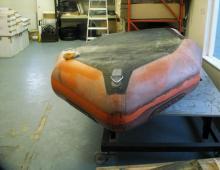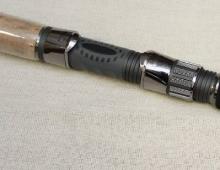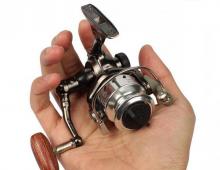Catching rotan in winter - subtleties and secrets
Rotan is a small predatory fish, the usual size of which does not exceed 25 cm and weighs 300 grams. There are reports of individuals harvesting 600 or more grams, but this is most likely an exception to the rule than a pattern. Catching rotan in winter is quite an exciting activity. Despite its small size, this predator bites actively throughout the winter period, which makes fishing not only interesting, but also productive.
Fishing methods
There are several ways to catch a rotan, or firebrand, from the ice - on a lure, on a mormyshka or on vents (postavushki). Each of the methods is good during certain periods of winter, and also depends on the activity of the fish, its size, as well as the preferences of the angler.
I. Mormyshka fishing.

This method is one of the most popular. Mormyshka - an artificial metal bait with a soldered hook. Can be used with or without nozzle.
Tackle selection
Choosing gear is not difficult - the small size of the predator allows you to use any fishing rod for winter fishing. Very often, fishermen use "balalaikas" with a nod. This rod has a number of advantages - light, comfortable, small in size, already equipped with a small reel that acts as a handle.
Fishing line - ordinary monofilament, with a diameter of 0.08-0.12 mm. It is worth noting that rotan does not belong to shy fish and greedily grabs prey, not being afraid of even thick fishing line, so even monofilament 0.2 mm thick will do. Often a thick line is needed - rotan is usually caught in thickets of underwater grass, where holds are a standard feature.
A short nod made of lavsan or silicone tube. You can buy at the store or make your own.
Lure characteristics
Mormyshka features:
1.Shape:
- pellet;
- crap;
- oatmeal;
- a drop;
- goat.
You can successfully use other models of mormyshkas - rotan is quite voracious and grabs the bait without looking too closely at the shape.
2. Material. Fishing takes place at a shallow depth, so tin and lead baits are suitable. If the fishing line is thick, then heavy tungsten mormyshkas should be taken, allowing you to quickly lower the equipment to the bottom.
3. Color. There is no specific coloration - fish preferences can change quickly. The best are light baits of white, gold and silver color.
size 4. Rotan has a huge head - up to a third of the body length, as well as a very large mouth, so it can easily swallow even a large mormyshka. It is preferable to use medium and large baits with 4-5 hook sizes - at the discretion of the angler. The predator swallows small mormyshkas very deeply, and it is rather problematic to extract them later. For the same reason, hooks should be with a long shank.
fishing technique
The game of mormyshka is not particularly difficult. Most often, this is touching the bottom with the bait, followed by a sharp rise of 20-30 cm and a pause, during which a bite follows. You can diversify the game by tapping the mormyshka on the ground and vibrations. You should not twitch the bait too often and for a long time - the firebrand does not often attack a moving bait, preferring to grab a motionless prey.
With a bad bite, especially in the wilderness, you should switch to a smooth game of tackle with long pauses or even catch on a motionless jig.
Rotan bites on a bare hook, but not often, preferring an additional animal bait. It can be caught on a revolver during the first ice period, when the fish is very active and grabs almost all baits indiscriminately. At this time, large specimens of rotan are often caught on a naked mormyshka.
II. Lure and balance fishing.
Actively used throughout the winter. This method is a lot like fishing for mormyshka. There are slight differences in the selection of gear:
The fishing line is used thicker - 0.16-0.20 mm.
The nod is hard, made of a metal plate or silicone, up to 7 cm long.
Lure Feature:
1. Size. Perch spinners are used for vertical wiring 2-3 cm long.
2. Color. Usually use spinners and balancers of gold or silver color. The best is the bait, the lower half of which is covered with a light-emitting substance, and the upper half is painted gold.
3. Hook. Either soldered or movably fixed with a long forearm. Lures equipped with a movable tee with an “eye” - a bright colored bead at the base of the hook, have proven themselves well.
fishing technique

The game is as follows: the bait is thrown over the bottom and released into free fall. At the bottom point, be sure to pause for a few seconds. Rocking the bait at the bottom or tapping on the ground can be effective.
As in the case of mormyshka, a predator rarely bites on a bare lure - at least a small piece of bait should always be present on the hook. In this case, the firebrand can grab even the spinners lying at the bottom.
In some cases, even bottom spinners are used - the front part of such a bait goes into the bottom soil, and the hook suspended in the tail attracts a predator prowling near the bottom with its vibrations.
III. Fishing with baits or hooks.
If a large rotan is found in a pond, then it can be successfully caught on vents. Of course. This method is not suitable for fans of active winter fishing, but the results can be quite good.
You can use the usual purchased vents for pike, only by removing the metal leash as unnecessary. It is also very easy to make a regular supply, which in terms of efficiency will not be inferior to purchased gear.
Delivery device:
A wooden stick is taken, the length of which exceeds the diameter of the hole.
Several meters of fishing line 0.3-0.5 mm thick are tied to a stick.
At the end of the main fishing line, a leash with a tee is attached;
An olive weighing 15-20 grams is fixed above the leash.
It is also very easy to use this tool. A live bait is attached to the hook, after which the tackle is lowered into the water until the weight touches the bottom. Excess fishing line is wound on a stick, which is laid across the hole. In the future, it remains only to periodically check the gear for the presence of prey.
The over-ice vent can be replaced with an underwater one. In this case, the fishing line is wound on a flyer made of wood and fixed in a slot made in one of the double ends. At the single end, the flyer is tied to a cord or wire, which is fixed on the surface of the ice or is also tied to a stick lying across the hole. In this case, the predator, grabbing the prey, pulls the line out of the slot, which, freely sliding off the flyer, gives him the opportunity to calmly swallow the bait.
Live bait is used as bait for bait fishing. Usually they take fish of the same species - cannibalism among rotans is very common. One point should be taken into account here - thanks to the huge mouth of rotan, very large prey is often enough, slightly inferior to it in size. In this regard, the use of small live bait is unlikely to lead to the capture of a large specimen. Many fishermen advise taking a large live bait weighing 60-70 grams.
It is better to stick the live bait not behind the back, but by leading the leash through the gills so that the hook is in the mouth. Further, the leash is fastened to the fishing line, and the live bait is able to remain in a mobile state for a long time.
Feed and bait
Opinions differ on the advisability of using bait for rotan. With a good bite, you can catch 4-5 kg of fish in just 2-3 hours, but there are recessions when rotan reacts poorly to prey, and it should be additionally lured.
Like any predator, rotan feeds exclusively on animal food and can be used as bait:
- offal;
- fresh fat;
- sausage;
- finely chopped fish or pieces of meat and other vital ingredients.
As a rule, it does not do without bait. It could be:
- worm;
- maggot;
- bloodworm;
- insect larvae;
- meat or fish pieces;
- salo;
- chicken skin;
- liver;
- easy.
Special mention should be made of the last bait. A piece of chicken skin is a very convenient and popular bait due to the following properties:
Elasticity and strength allow you not to change the bait throughout the fishing day.
Subcutaneous fat attracts firebrands very well with its smell.
The coloring makes the bait very noticeable in the swampy water where the rotan lives.
Due to its lightness, a piece of skin in the water floats horizontally, resembling live prey.
You need to cut off a small piece of an elongated triangular shape. Then it folds along and is fixed on a hook for a thick base.
Rotan is not too fond of bait that has been in the water for a long time. Therefore, even chicken skin should be changed at least once every half an hour, and other baits much more often.
Fishing places

It must be said right away that rotan is very unpretentious to the quality of water and reservoirs. It prefers abundantly overgrown reservoirs with stagnant water, therefore it is successfully caught in ponds, wetlands, oxbow lakes.
It rushes to prey from an ambush, so the catchable places are as follows:
accumulations of algae;
snags and blockages;
borders of thickets and free water;
areas near the shore, abundantly overgrown with reeds or reeds;
depth differences.
Depending on the period, the parking places of the rotan change:
1. The beginning of winter. According to the first ice, the predator is very active and is caught throughout the reservoir. Particular attention should be paid to shallow coastal areas with vegetation, about a meter deep.
2. Middle. In late January - early February, oxygen in the water becomes less and less and the bite is significantly weakened. The fish leaves the shore closer to the middle of the reservoir and stays near blockages of snags and depth drops. It can also be found near underwater springs, where the amount of dissolved oxygen is quite high. On small and small reservoirs, biting may be completely absent.
3. End of winter. With the approach of spring, rotan is activated and begins to feed intensively. It moves after the fry closer to the coastal areas, where streams of melt water flow.
Tactics and secrets of fishing

Having chosen a suitable site, you should prepare for fishing by drilling at least a dozen holes. It is better to place them at a distance of about 3 meters from each other in a checkerboard pattern. They start drilling near the shore, gradually moving towards the middle of the reservoir.
They fish in turn, starting from the first hole, allocating bait for each 3-5 minutes of the game. Since this predator does not form large flocks in winter, it will not work to catch a large number of fish from one hole.
Quite often, rotan is caught on several nodding rods at the same time. To do this, you need to use baited bait. The tackle is lowered into the water, and the rods are placed on the ice on stands. The bite is sharp and usually does not require hooking. A rotan that has grabbed the bait is unlikely to break loose - thanks to its large mouth and greed, it immediately swallows the prey, and the hook is deep inside.
When using a homemade signaling device, it can be easily fixed with a small alligator clip attached to the end of the rod.
If the bite is not too active, then you can periodically go around the holes with installed fishing rods and play with the bait. This tactic, of course, is more tiring for the angler, but it allows you to draw the attention of the predator to the bait.
Sometimes there is a completely original catching of rotan in winter - it is cut down directly from the ice. The fact is that this fish is very tenacious and able to withstand the complete freezing of the reservoir. In this case, the firebrands are knocked down into a dense lump, covered on the outside with a layer of mucus secreted by them, and in this form they hibernate, freezing into ice. As the water temperature rises, the fish thaws and comes to life without harm to health.
Without an extractor, it will be very problematic to extract a deeply seated hook.
Rotan usually keeps near the bottom, so the height of fishing rarely exceeds 50 cm.
A quick change in weather entails a sharp deterioration in the bite.
When fishing with a fixed bait, a nod can be easily replaced with a float. The main thing is to clean the holes in time so that it does not freeze into ice and does not lose sensitivity.
Lures and mormyshkas with luminous areas are effective - in muddy, abundantly overgrown water, where rotan is often caught, such a bait will be noticeable even in cloudy weather.
The breeding rotan, which originally lived in the Far East, is becoming an increasingly popular object of winter fishing. Quite tasty white meat, in which there are practically no bones, also contributes to this. And if we take into account that fishermen report catching individuals weighing one and a half, two, or even three kilograms, then catching rotan in winter also turns into a real hunt for trophy specimens.



